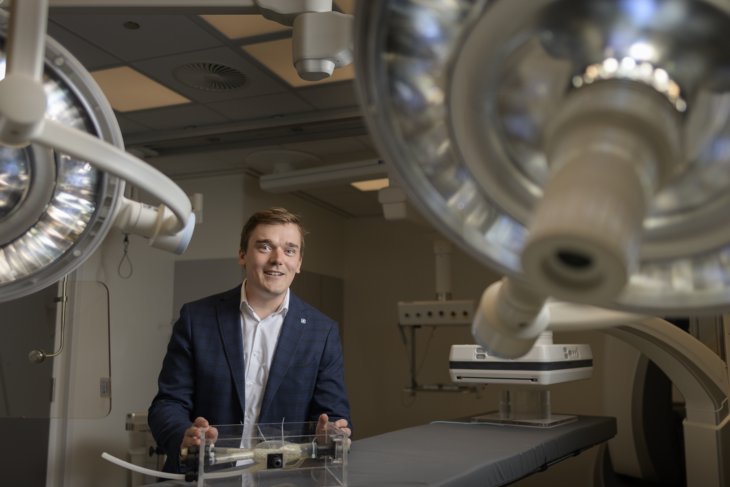With his background as a technical researcher in a clinical setting, Jelmer Wolterink is in the right place at the MIA research group at the University of Twente. He studied AI, obtained a master’s degree in mathematics, and earned a PhD for his research into improved diagnostics of coronary artery calcification using AI. “I didn’t have a background in healthcare, so I ended up there by chance,” he says. “But it turned out to be a good choice. I enjoyed the PhD topic, and it has social relevance. It’s great to be able to apply your knowledge in a way that, through collaboration with the right partners, can have an impact on patients.”
That is exactly the aim of MIA, Wolterink continues. “What’s interesting about working here is that we – including our Technical Medical Centre (TechMed Centre) and in collaboration with other research groups – are concretely bringing technology into healthcare. I previously worked at academic hospitals in Utrecht and Amsterdam, but at the University of Twente we approach important issues in AI and healthcare with a unique technical perspective. For example, how we can make AI more reliable and embed prior knowledge into existing AI models.”
What sets us apart
AI is being researched in many places to automate human tasks. “One key aspect that distinguishes MIA is that we use the geometry of data,” Wolterink explains. “Embedding such prior knowledge into a model makes it possible for the model to learn from fewer examples. For instance, take an image of the heart that can be rotated and presented to a model in various ways. If the model already has that rotation built in, it can learn from fewer images.”
Wolterink also points out that MIA approaches image analysis from a mathematical perspective. “We look at how reliable the method is and when we can or cannot trust the results. Our mathematical background gives us a different viewpoint than clinically driven research groups.”
Practice-oriented research
Two examples of MIA’s research include developing an algorithm to detect prostate cancer on MRI scans, and creating models that can predict how a disease – such as an aneurysm – will progress.
“We do more as a research group,” Wolterink emphasises, “but we have a strong background and robust collaborations in the field of cardiovascular disease. The aneurysm research is built on a Veni grant and is a collaboration with hospitals in Amsterdam, Arnhem, and Groningen, among others. They hold a large amount of historical data on how aneurysms develop. Based on that, we’re investigating whether we can determine when intervention is necessary, and whether we can predict the outcome of an intervention after a year – so the right treatment can be chosen for individual patients.”
The prostate research is a collaboration with Radboudumc, UMC Groningen, and Siemens Healthineers. Wolterink says: “It’s a highly relevant topic, especially now that prostate cancer diagnoses are increasingly making the news. It’s fascinating to work with clinicians on this.”
Collaboration
A good example of cooperation with clinical partners, businesses, and fellow researchers is the Innovation Center for Artificial Intelligence (ICAI) lab. ICAI is an initiative of the University of Amsterdam and VU Amsterdam and is led by Professor Maarten de Rijke, a specialist in AI and information retrieval at the University of Amsterdam.
“The motivation behind ICAI is to focus more on problem-driven research,” says Wolterink. “We at the University of Twente are participating in the Healthy AI Lab – together with Radboudumc, UMC Groningen, and Siemens Healthineers – in five projects that contribute in various ways to better use of AI for prostate MRI. This lab was set up as part of a major national programme which received NWO funding two years ago: LTP ROBUST. Seventeen public-private ICAI labs are involved. At MIA, we contribute to developing robust AI. We’re researching how to make the acquisition and analysis of MRI scans for prostate research faster and more reliable with AI.”
One of the challenges, Wolterink adds, is that each hospital uses its own scanner or protocol, and patient populations can differ too. “This can affect image analysis, and we try to minimise that variation. Another part of the research is about how to combine images taken from the same patient over time. We investigate how imaging is done and what AI can add. The Healthy AI Lab is a great example of the strength of the TechMed Centre, where technical research and medically relevant challenges meet.”
Six key elements
All algorithms developed within the LTP ROBUST programme are assessed based on six criteria: accuracy, explainability, reliability, reproducibility, resilience, and safety. “A key factor in the acceptance of AI is that the user understands why the model is confident in its prediction,” says Wolterink. “The method for this can be built into the model, but the balance with performance must be carefully managed. We’re also conducting research on how to communicate uncertainty in the results. Ideally, that uncertainty should align with the areas where errors occur.”
Wolterink also highlights the importance of legislation and ethics. “In recent years, there’s been a huge surge in attention for AI in healthcare. The fields are evolving rapidly, and legislation and ethics have become research domains in their own right. It’s positive that ICAI also involves experts in law and social sciences. There’s a great deal of interest in hospitals to implement AI, and I think we have a lot to offer in that regard. Healthcare really needs domain-specific AI applications – like the ones we’re developing. Our collaborations with the healthcare sector and Siemens Healthineers ensure that what we create is truly applicable in practice.”



